size-of-ensemble
Bridge – 4 More Short Pieces – Flute or Alto Flute (and Piano)
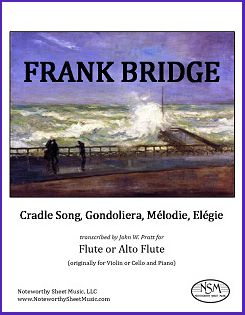 Cradle Song, Gondoliera, Mélodie, and Elégie, by Frank Bridge
Cradle Song, Gondoliera, Mélodie, and Elégie, by Frank Bridge
Transcribed for Flute or Alto Flute (and Piano) by J. W. Pratt
Flute Part, Alto Part, PDF $11.99
Like the 4 Short Pieces for Violin and Pianoforte published in transcription by Noteworthy Sheet Music previously, these additional four short pieces by Bridge "provide a fine and delightful introduction to an accessible post-romantic composer who should be better known." Published by Bridge between 1903 and 1911, the works included in our second edition are transcriptions of Cradle Song, written for violin or cello and piano, Gondoliera for violin and piano, and Mélodie and Elégie for cello and piano. Mr. Pratt has created transcriptions of all four pieces for both flute and alto flute, and we include both instrument versions in this combined edition. We think Cradle Song and Elégie are particularly beautiful on the alto flute, but all are effective on either instrument, so we prefer to let our flutists decide on which instrument they choose to play each piece. We provide our flute and alto flute parts only; the original piano scores work well with our transcriptions and are available, along with the violin and cello parts, as free pdf downloads at imslp.org—click the links to access the scores for Cradle Song, Gondoliera, Mélodie, and Elégie.
Flute part, 6 pages; Alto Flute part, 6 pages; Total, 14 pages.
PreviewBridge – 4 Short Pieces – Flute or Alto Flute (and Piano)
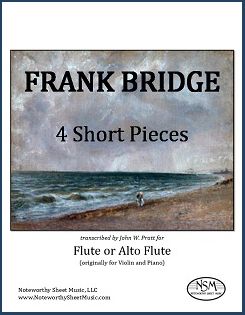 4 Short Pieces, by Frank Bridge
4 Short Pieces, by Frank Bridge
Transcribed for Flute or Alto Flute (and Piano) by J.W.Pratt
Flute Part, Alto Part, PDF $8.99
The 4 Short Pieces by Frank Bridge were written for violin and piano, and first published in 1912. As noted in John Pratt's foreword to the edition, they "provide a fine and delightful introduction to an accessible post-romantic composer who should be better known." The pieces are Meditation, Spring Song, Lullaby, and Country Dance. Mr. Pratt has created transcriptions of the violin parts for both flute and alto flute, and we include both instrument versions in this edition. We think Nos. 1 and 3 sound particularly nice on the alto flute and No. 4 is a splendid romp on the C flute, but all four are effective on either instrument, so we prefer to let our flutists decide on which instrument they choose to play each piece. We provide only our flute and alto flute transcriptions; the piano score, including the original violin part, is available as a free pdf download at imslp.org.
Flute part, 5 pages; Alto Flute part, 5 pages; Total, 14 pages.
PreviewBridge – Two Pieces: Pensiero and Allegro appassionato – trans. for Clarinet and Piano
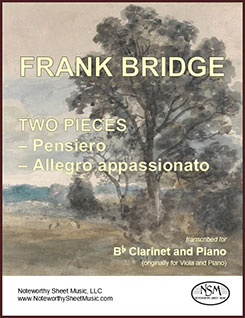 Two Pieces: Pensiero and Allegro appassionato, by Frank Bridge
Two Pieces: Pensiero and Allegro appassionato, by Frank Bridge
Transcribed for B-flat Clarinet and Piano by C.A.Vater
Score and Part; PDF $10.99
Certain chamber works written for viola can also work very beautifully when transcribed for clarinet, and indeed may actually be coveted by clarinetists. Brahms’ Two Songs for Voice, Viola and Piano, Op. 91 is one such piece, and our transcription has become one of NSM’s most popular publications. Clarinetists may discover that our adaptation of the viola part of Frank Bridge’s Two Pieces: Pensiero and Allegro appassionato, written for viola and piano, is also well-conceived and enjoyable to play. As suggested by their titles, these two pieces were written in very different styles, but they complement each other well, showing off Bridge’s composing versatility and providing performers an opportunity to display a range of emotions and capabilities. In our edition, we have raised the Pensiero key from F minor to G minor, taken a few passages in both pieces 8va to bring them into clarinet range, and created clarinet-friendly adaptations for the viola’s occasional double stops, but otherwise the pieces remain as Bridge composed them.
Score, 10 pages; Clarinet part, 3 pages; Total, 16 pages.
PreviewBruch - Eight Pieces - Alto Flute
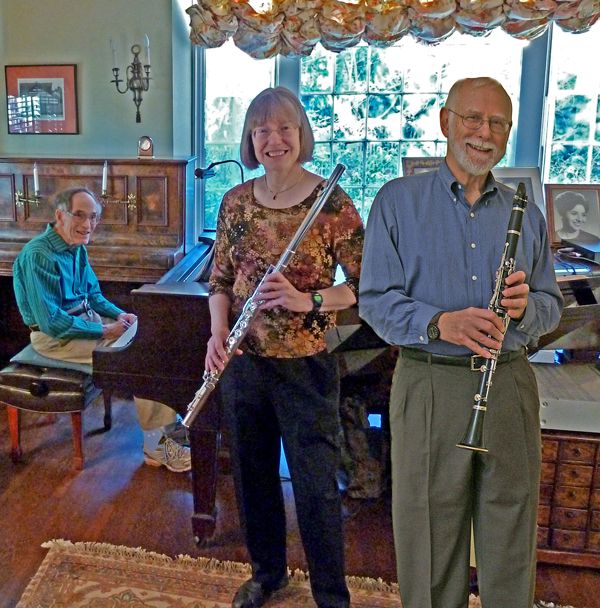 Acht Stücke, Op.83, by Max Bruch
Acht Stücke, Op.83, by Max Bruch
Transcribed for Alto Flute (with Clarinet and Piano) by Davies, Pratt, and Vater
Alto Flute Part, PDF $9.98
Originally scored for clarinet, viola, and piano (or violin, cello, and piano), Bruch's Acht Stücke (Eight Pieces) adapts nicely for a trio with clarinet, alto flute, and piano. Bruch's beautiful melodies are well served by the rich tones of the alto flute.
In creating this transcription of the viola part for alto flute, we have taken great care to maintain the spirit and character of the original instrumentation. We provide here the alto flute part. The piano and clarinet parts are readily available in the public domain as free pdf downloads of the score and parts. Here is a link to one such source: Piano Score and Clarinet Part
Alto Flute part, 17 pages; Total, 19 pages.
PreviewBurleigh - Southland Sketches, Nos. I, III, IV - Alto Flute or Flute (& piano)
 Southland Sketches, Nos. I, III, IV, by H. T. Burleigh
Southland Sketches, Nos. I, III, IV, by H. T. Burleigh
Transcribed for Alto Flute or Flute (and piano) by C. A. Vater
Alto Flute part and Flute part, PDF $9.96
Harry Thacker Burleigh was an acclaimed African-American singer, music editor, and composer whose adaptations of African-American spirituals became famous. His Southland Sketches, which were composed for violin and piano and published by G. Ricordi in 1916, are a fine example of Burleigh’s quintessential American style. The original composition included 4 movements. Our edition excludes the second movement, but adapts three of the original four miniatures for either alto flute or flute. We provide only the transcribed alto flute and flute parts, as they have been designed to work well with the piano part in the original score for violin and piano which is available as a good quality, free pdf download from imslp.org. Performers may choose to play all three of these pieces on either flute or alto flute, or switch instruments between sketches, depending on personal preference.
Alto Flute part, 6 pages; alternate Flute part, 6 pages; Total,18 pages. (pdf of piano accompaniment is freely available at imslp.org)
PreviewCoste - Cavatine - Afl + Pf
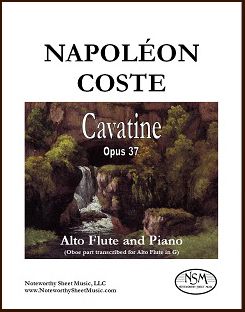 Cavatine, Op.37, by Napoléon Coste
Cavatine, Op.37, by Napoléon Coste
Transcribed for Alto Flute and Piano by C.A.Vater
Piano Score and Alto Flute Part, PDF $8.25
Napoléon Coste (1805-1883) was born in a small village in the Départment of the Doubs, France. He began to play guitar at the age of 6, studying with his mother who was an accomplished guitar performer. Napoléon himself began teaching and performing on guitar as a teenager. At age 24 he moved to Paris, where he studied under Fernando Sor, the renowned Spanish classical guitarist and composer. Coste quickly established himself as a virtuoso and is widely acknowledged as the dominant French guitarist of his era.
Coste became famous not only as a guitar soloist, but also as a major composer of some 60 works, most of which were written for guitar. His Op.37 "Cavatine" is a short, single-movement piece composed for piano and oboe (or violin or flute). The work is lovely, melodic but lively in places; it falls nicely within the range of the alto flute and sounds appealing and completely natural on that instrument. The Noteworthy Sheet Music edition includes a score for piano and alto flute, in addition to the transcribed alto flute part.
Alto Flute part, 3 pages; Piano Score, 8 pages; Total, 16 pages.
PreviewCoste - Les Regrets - Afl or Fl (or Ob, Vn) and Pf (or Guitar, Harp)
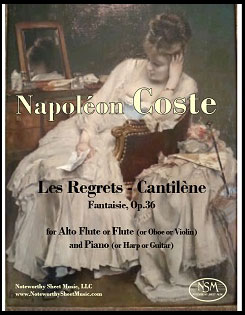 Les Regrets-Cantilène, Op.36, by Napoléon Coste
Les Regrets-Cantilène, Op.36, by Napoléon Coste
Transcribed for Alto Flute or Flute (or Oboe or Violin) and Piano (or Harp or Guitar) by C.A.Vater
Score, Alto Flute Part, and alternative Flute (or Oboe or Violin) Part, PDF $5.99
Napoléon Coste (1805-1883) became famous not only as a guitar soloist, but also as a major composer of some 60 works, most of which were written for guitar. His music is in the romantic French style and appreciated for its originality. His Fantaisie, Op.36, Les Regrets-Cantilène, is a short, single-movement piece written for oboe or violin with piano or harp or guitar. We created our Noteworthy Sheet Music edition from the difficult-to-read manuscript version in the public domain, available on imslp.org. We include a score in concert pitch and a part suitable for flute, oboe or violin, as well as a part transcribed for alto flute in G. The piece falls nicely within the sweet range of the alto flute and our transposition sounds appealing and completely natural on that instrument. In fact, Les Regrets-Cantilène is gorgeous on either flute or alto flute. Melodic and sentimental, the work is not overly demanding technically and should appeal to players of a moderate or higher skill level.
Score, 4 pages; Alto Flute part, 1 page; Flute (or Oboe or Violin) part, 1 page; Total 8 pages.
PreviewD’Indy - Choral Varié, Op.55, trans. Alto Flute
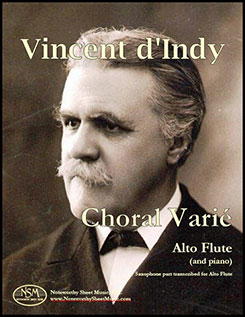 Choral Varié, Op.55, by Vincent d’Indy
Choral Varié, Op.55, by Vincent d’Indy
Solo part transcribed for Alto Flute by C. A. Vater (originally for saxophone or viola)
Part for Alto Flute, PDF $5.99
D’Indy composed his Choral Varié pour Saxophone solo (ou Alto) et Orchestre, Op.55 in 1903. The composer also created an orchestral reduction arrangement, published by Durand, Paris, 1903, for alto saxophone (or viola) and piano; it is this edition that we used as the basis for our transcription of the solo part for alto flute. The Choral Varié piece is appealing and distinctive, solemn and tender. It adapts nicely to the alto flute, highlighting the beautiful, intimate quality of that instrument’s low-register tones. Our publication provides only our transcribed alto flute part; the piano part, published as the composer’s score in concert pitch for solo and piano, is freely available as a PDF download from imslp.org.
Alto Flute part, 3 pages of music; Total, 6 pages.
PreviewDanzi - Grande Sonate - Piano & Basset Horn
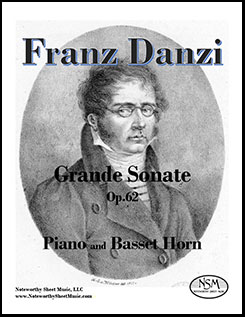 Grande Sonate, Op.62, by Franz Danzi
Grande Sonate, Op.62, by Franz Danzi
for Piano and Basset Horn; re-notated, edited, and with occasional ossia elaborations suggested by John W. Pratt
Piano Score and Basset Horn Part, PDF $13.99
Franz Danzi (1763-1826) was an active musician, cellist, and teacher in Mannheim, Munich, Stuttgart, and Karlsruhe. A prolific composer, especially of music for the stage and chamber music from keyboard solos to sextets, he revered Mozart and mentored Weber. His wind quintets are notable. His Grande Sonate, Opus 62, for piano and basset horn, was published about 1823, along with an alternative cello part which sometimes differs from the basset horn part in other ways than octave transposition. // The original publication of Danzi’s Opus 62 is available at imslp.org., but there is no full score and the parts are hard to play from, or sometimes even to read at all, lack measure numbers, have a few errors, and differ in the number of measures in the last two movements. We have therefore prepared a full score including the basset horn in concert pitch, to facilitate checking the fit of the basset horn and piano lines and our transcriptions for other instruments against the original. — excerpted from John Pratt’s foreword to the edition
Piano Score, 28 pages; Basset Horn part, 7 pages; Total 40 pages.
PreviewDanzi - Grande Sonate - Piano & Flute
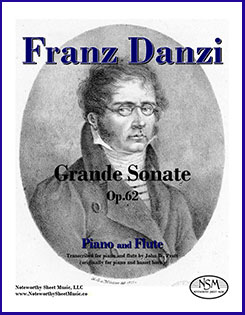 Grande Sonate, Op.62, by Franz Danzi
Grande Sonate, Op.62, by Franz Danzi
transcribed for Piano and Flute by John W. Pratt
Piano score and Flute part, PDF $14.99
excerpted from John Pratt’s foreword to the edition: 'Franz Danzi (1763-1826) was an active musician, cellist, and teacher in Mannheim, Munich, Stuttgart, and Karlsruhe. A prolific composer, especially of music for the stage and chamber music from keyboard solos to sextets, he revered Mozart and mentored Weber. His wind quintets are notable. His Grande Sonate, Opus 62, for piano and basset horn, was published about 1823, along with an alternative cello part which sometimes differs from the basset horn part in other ways than octave transposition. // The sound of the basset horn varies widely, depending on its construction, who is playing, what is being played, and who is describing it. George Bernard Shaw said, ''The devil himself could not make a basset horn sparkle.'' Burnet Tuthill, in Cobbett's Cyclopedic Survey of Chamber Music (1929), wrote of its "soft mellow timbre of rich beauty.” E.T.A. Hoffmann likened its sound to the scent of red carnations (see Georgina Dobré, The Basset Horn, who says, pace Shaw, “Sparkle it certainly can!”). That tent is broad enough to cover the characteristics of both the flute and the clarinet comfortably, and Danzi’s Grande Sonate alternates sparkle and mellow rich beauty in large measure.' Since we at NSM have grown quite fond of this piece, we decided to transcribe it for both flute and clarinet, so we and our friends could enjoy playing it. We offer here the flute edition, with a version for clarinet to follow in the coming weeks.
Piano score, 28 pages; Flute part, 7 pages; Total 40 pages.
Preview